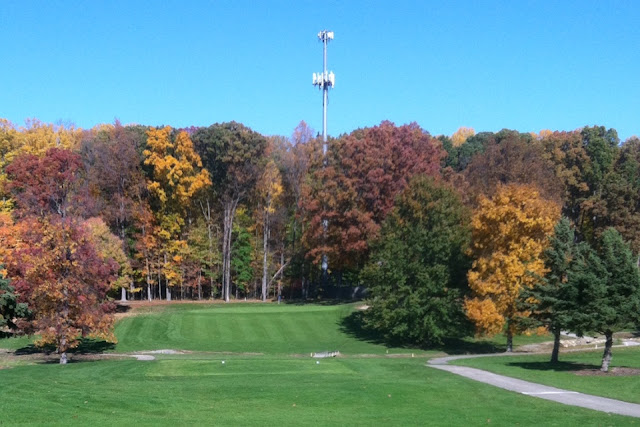(The eighteenth is well defended by water and sand. Pin placement is very important, and can make this a difficult hole or a birdie opportunity.)
Geoffrey Cornish designed Zoar in 1975.
(The tenth is a 425 yard dogleg right par four. The approach is a long iron uphill shot to the green. Easily the toughest par on the course.)
Zoar is plenty lenient from the tee. Most fairways have room to drive the ball, and the flat terrain rarely demands a precise tee shot. The challenge is going to come at the greens. Cornish liked to put little knobs and ridges in them, separating receptive areas from tight defended ones.
(Look how wide the par five second green is! Besides having room out to the right and behind the sand trap, the green extends left, past the hazard. That's variety!)
(A knob in the front half of the third green separates the left and right pin positions. The rear portion narrows with fall offs on both sides, making another interesting hole location.)
(Only the front third is visible on the 210 yard fourth. The other two thirds wraps around the bunker. Pins in the rear can be very difficult to get close.)
(Cornish's bunkers have been described as "floating in the air." In reality, fill is used to make a mound, then a bunker is carved into it.)
(The ninth does challenge the driver to carry the fairway bunker or skirt around it.)
Zoar hosts several big tournaments each summer, The Gatorade Collegiate associated with Wooster College, Yuengling Tuscarawas County Championship, and Zoar Senior Amateur, to name a few. With the ability to tuck the pins, the course does a good job defending itself. The par threes in particular are a strong set. Two of them are well over 200 yards.
(The 167 yards fifteenth is the shortest par three, with a right to left tilt making a back right pin very tough to get close.)
Any lost strokes can be gained back at the par fives. Each one is reachable, and depending on pin position, eagle is a possibility.
(The reverse camber twelfth has a late dogleg. This pic of the rear left section shows just how isolated a pin back here can be. There's no bunker short to help gauge the distance either.)
The last three holes are par fours.
(The 340 yard seventeenth is potentially driveable if one can carry over the trees in dogleg. The best play is laying up, and hitting a short iron in.)
(The view of eighteen green from inside the bunker. Not an easy shot with all the marbles on the line. Also, it's the only water on the course.)
I was here the first weekend of December, and the course was in good shape. It was soft, but dry, and the greens rolled really nice. The group behind me came all the way from Mentor! That's a great endorsement for Zoar's commitment to winter golf. The guy told me they come because course is in good shape, it's a nice track, and they have covered carts. I like Zoar. It's definitely better than Wilkshire down the road. I give it a 4 (above average)(worth 30-45 min drive). In the winter, double the drive time. It's still cheaper than going south.
(Get a little heater and BAM it's time to golf!!)



















































